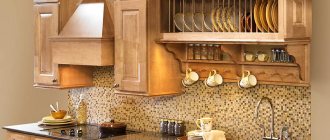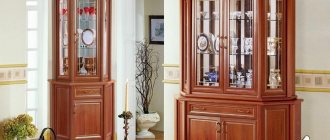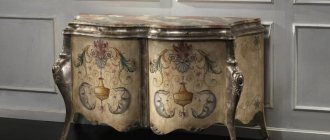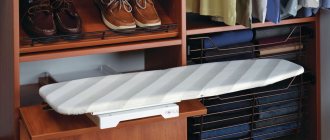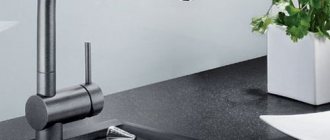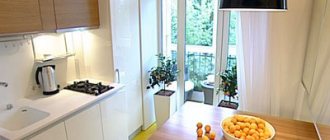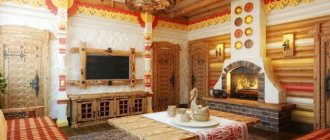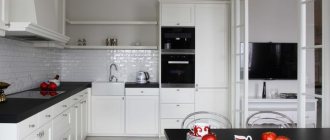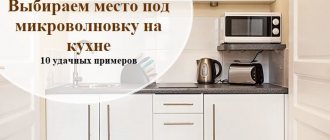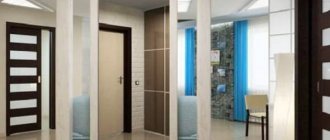French furniture makers who lived in the 18th century gave the world such a piece of furniture as a sideboard. The main purpose of the sideboard was to place exquisite dishes and interior decorations. At that time, dishes made of ceramics and porcelain were so expensive that they often became the main source of pride for the owners. According to French fashion of the 18th century, elegant gravy boats, bowls and cups were displayed in the most prominent place in the house, emphasizing the high status of their owners. However, storing expensive dishes on the surface of chests of drawers, shelves and tables was unsafe, and hiding them behind thick cabinet doors was unwise. Therefore, the craftsmen decided to create a piece of furniture that would allow them to demonstrate the beauty of porcelain utensils, while at the same time taking care of their safety. This is how the sideboard appeared - a cabinet with glass front doors, which over time turned into a mandatory piece of furniture in every home.
Despite its venerable age, the sideboard is still popular with designers. Today we invite our readers to consider the design features of sideboards, as well as ways to place these pieces of furniture in modern interiors.
Sideboard for dishes in the living room
Construction and design of classic sideboards
The design of the sideboard resembles a table buffet. But, unlike a buffet, a sideboard can consist of several sections, each of which is designed to store certain things.
In its classic embodiment, a sideboard is a piece of furniture, conditionally consisting of two elements:
- upper body with glass doors;
- bottom chest of drawers.
The world's first sideboards were made exclusively from precious wood. The fashion of the 18th century demanded ornateness, sophistication and pretentiousness, so sideboards were often decorated with complex carved elements, gold plating, curved legs and rich fittings. At the same time, the sideboard could be made either in the form of a single structure or in the form of two independent elements - a massive wide chest of drawers and an elongated high display case. The chest of drawers, as a rule, was equipped with shelves or drawers in which housewives stored kitchen utensils or textile items. As for the display case, its space was divided by shelves into several sectors, thanks to which it was possible to place a lot of tableware and porcelain items.
Beautiful sideboards for dishes in the living room photo
Sideboards for the living room
Another difference between a sideboard and a buffet is the presence of doors. If the upper part of the buffet can be open, then the sideboard showcase, as a rule, was equipped with doors with glass elements. Depending on the shape and design features, this piece of furniture could have one, two or several doors, which were often complemented by wooden frames, doors and decorative details.
Sideboard for dishes photo
Despite the fact that the sideboard was originally created to store dishes and cutlery, this piece of furniture could be placed not only in the kitchen or dining room, but also in any other room. For example, the interior fashion of 18th-century France made it possible to place a sideboard in the most prominent place in the living room or reception hall.
Sideboards for the living room photo
In our open spaces, the sideboard gained popularity in Soviet times. But since at that time people preferred maximum simplicity and conciseness, the design of this piece of furniture was greatly transformed. The facade of the Soviet sideboard was not decorated, but was carefully cleaned and polished, which is why the product began to look like a kind of cupboard.
Sideboards for the living room photo
Sideboard for dishes in the living room photo
It may seem that a sideboard is purely decorative furniture, which is used in modern designs only to add additional style. However, this is not only a beautiful, but also quite functional item that allows you to organize a convenient storage system for things and utensils.
Modern sideboard with wine compartments
Sideboard display for the living room
Soviet sideboard
Looking back, we can remember that the sideboard was one of the integral elements of any apartment in the Soviet Union. In such a cabinet, Soviet citizens placed anything they wanted, from all sorts of souvenirs to sets and dishes. Today, in modern realities, the sideboard is not so popular among people, but the fashion for it is gradually beginning to return.
Why do you need a sideboard? Sideboard function
The original function of the sideboard was to store dishes. These are various sets for tea and coffee, sets of glasses and glasses, crystal sets, etc. All these things were placed on shelves and stored for a very long time. Now inside the sideboards you can see books, candlesticks, various souvenirs, vases, and photographs. To make it easy to reach the shelves, the height of the sideboards is made small. There are sideboards with a lower part made of wood, where dishes are stored for constant use, and the upper part is glazed. Some models of sideboards also have space for a minibar. Based on this, you need to choose a sideboard for the purpose for which it will be used in the future.
Types of sideboards
Sideboards with open shelves and glass doors are suitable for storing sets of dishes and crystal, vases, candlesticks, aroma candles, souvenirs, books and other things. These can be cabinets consisting of 1 or 2 sections, which have up to 2 doors and multi-level shelves. There are models with internal minibars that can accommodate alcoholic drinks, a tray, a corkscrew, several glasses and glasses. On modern models, spotlights are installed to effectively visualize the dishes and sets located inside or to give the room comfort from the warm light of the sideboards when the main light is turned off. Sideboards also have uppermost shelves or mezzanines, which are used to store all kinds of things and household utensils. Mezzanine doors are opaque and are most often made of the same material as the cabinet itself.
Modern sideboard
Recently, cabinet-type furniture has become most in demand. Cabinets from several sections can be presented in different compositions by changing the positions of the constituent elements, which gives them uniqueness and originality. For the production of cabinet furniture, materials such as chipboard, MDF, solid wood elements, metal parts, glass, and veneer are used. On the shelves of sideboards you can place various household appliances: TVs, record players, home theaters, etc. You just need to take into account the weight of this or that equipment and the strength of a particular shelf.
Sideboard materials
Furniture manufacturers often use special compounds to protect it, increasing service life and increasing strength. Typically, any sideboard is made from solid wood. Glass doors are decorated with patterns, carving elements, and multi-colored mosaic details. There may also be a special, exclusive model of such furniture. In this case, some valuable type of wood is used. And for decoration they use elements made from expensive materials, made by hand. When the doors are transparent, they are illuminated. Choose the most convenient option. Most often, small halogen lamps are attached inside, the light from which illuminates not only the inside of the cabinet, but also gives the entire living room a beautiful and stylish look. Sideboard doors are made of glass, plastic or wood. Opening methods can be different - either a sliding “compartment” or regular doors (one- or two-fold). The material used in the manufacture of shelves can also be different and must fit into the overall design of the sideboard, as well as correspond to the load-bearing function of their use. For example, sideboards from European manufacturers sometimes look like real masterpieces and works of art. This applies both to simple cabinets for storing various utensils, and to mini-walls with different functionality. Their design features fine carving work, various individual handles, unusual external shapes and various expensive decoration elements. Materials from European manufacturers are oak, cherry, mahogany, beech, which are very expensive on the wood market. In Russia, Karelian birch and wood-like materials are mainly used in production.
Sideboard in the interior
The sideboard is one of the main interior elements in the living room. In addition to the fact that it performs the function of storing various household items and utensils. A properly selected sideboard can also add or dilute the overall style and composition of the room. The rear mirror walls of the cabinet will allow you to visually change the interior space of the sideboard and the living room as a whole. Drawers and upper mezzanines give sideboards additional practicality when using them.
Photo. Soviet sideboard
Photo. Soviet sideboard
09.01.2019 1920
go to sections
Items you may be interested in:
Roman chariot
Rare antique figurine in the form of a Roman chariot. A two-wheeled chariot drawn by two horses is depicted. The chariot has a vertical…
16000 ₽
Panther (Polonsky ZhK)
Soviet porcelain figurine of a Panther (other names include “Puma” and “Cat”) produced by the Polonsky Art Ceramics Factory. Height one hundred...
600 ₽ 750 ₽
Candlestick Lady
Rare antique antique candlestick Lady (girl, woman) standing at full height and holding a candle bowl on her head with one hand. This p…
12000 ₽
Modern sideboard
Designers love to use chic, classic sideboards to highlight the beauty of certain interior styles. However, due to excessive ornateness, a classic sideboard is unlikely to become a harmonious element of modern designs, so this piece of furniture has been slightly transformed to suit today's requirements and preferences.
Unlike its ancestor, a modern sideboard is made not only from wood, but also from many other materials - acrylic, plastic, stainless steel, glass, etc., which allows you to give it absolutely any decorative direction.
Design modifications also affected the design of the product. Today's sideboard is not a symbiosis of a sideboard and a cabinet, but a universal piece of furniture that allows you to solve many functional problems. For example, almost every major furniture manufacturer produces corner sideboards for the living room, the design of which includes wide and narrow shelves, pull-out elements, drawers and cabinets. Thanks to its angular shape, such a piece of furniture does not take up extra space, but at the same time opens up great opportunities for arranging many things - dishes, interior decorations, books, etc.
Corner sideboard for the living room
Nowadays, dishes have not only a utilitarian purpose, but also perfectly serve as a decorative element. The design of your living room, dining room or kitchen can be complemented by colorful vases or dishes, and initially some of them could be created specifically for the purpose of decorating your home, and not just serving as a stand for food on your table.
How to beautifully arrange dishes in a closet
Sets, which sometimes represent a real work of art, are sometimes passed on by inheritance. They can retain their original beauty with proper care, so it is best to store them behind glass. In addition to ordinary cabinets, display cases, cupboards, sideboards, cabinets and hanging modules are used.
If you have a lot of shelves and a choice, it is better to arrange the dishes as follows.
Heavy objects (voluminous vases, tureens, clay dishes) are placed at the bottom for safety reasons, and compositionally this is a more advantageous option.
Do you have a beautiful china set for 12 people? It is better not to display it in full, especially since individual items are duplicated and presented in several copies. Choose the most beautiful ones (gravy boat, large plate, salad bowl, milk jug) and place them beautifully behind glass. The rest can be removed.
If the rear objects are lost against the background of the large front ones, they can be raised to the desired level. Let's approach this issue creatively - for example, we will cover boxes of different sizes with decorative paper. This is described in more detail in this video (the advice is suitable not only for a display case in a store, but also for a shelf in a cabinet):
Using the advice, you will understand that getting dishes out will become much easier.
In any case, it is advisable to place those items that you use more often closer to the doors. Large plates are best placed vertically, against the back wall. Make sure that they stand securely - otherwise, when the massive plate “goes” down, it can pull the lighter ones with it, and trouble will occur.
It is better to place the crystal separately. Fragile dishes are usually placed at eye level. Place small glasses around a tall wine glass or glass. Low objects are also sometimes brought to the fore.
Elegant plates and glasses will look beautiful if you equip the shelf with lighting. You can also place an LED light source in a crystal candy bowl or vase. The rays will be beautifully refracted on the faceted shot glasses and glasses placed around. This looks especially impressive if the cabinet has a mirrored back wall.
Stained glass dishes look great on glass shelves. It is also advisable to use lighting here, especially if the chandelier is located far from the cabinet.
All items must be combined with each other, in harmony. Don't clutter the space. The desire to demonstrate all the “wealth of choice” is not very good for visual perception. It is better to choose the most beautiful objects and arrange them advantageously. The dishes can be combined with figurines, bouquets of dried or artificial flowers and decorative candles.
Place the most beautiful item from the service separately - for example, in a special stand or hanging it on a nail. It is, of course, desirable that this service be located in the same room to create a holistic image.
Of course, it is better not to put large utensils on which you cook (saucepans, frying pans, pots) on display for guests and put them on the lower shelves of cabinets - unless, of course, this utensil is a work of art. Although in this case you are unlikely to cook with it every day. And if you do, she will probably lose her impeccable appearance. Cutlery is also usually stored in closed drawers.
Pay attention to your sideboard: if it is made of dark wood, light-colored dishes will look more advantageous in it, and if it is light, choose bright, rich colors. Agree, if you have a white cabinet, walls and carpet, red or blue dishes will look very impressive, white ones will simply get lost against the background of everything around you (unless, of course, you are a fan of hospital interiors).
Antique porcelain dishes look great in classic wooden cabinets, modern ones look great in sideboards with simple shapes.
Collecting often develops into the meaning of life. Collecting quietly penetrates not only into a person’s heart, but also into the interior of his apartment. And the integrity of the perception of the home depends on how well the objects dear to the heart are arranged. To avoid turning your own apartment into a warehouse, try using ideas from our catalog.
Purchasing porcelain figurines one after another or periodically bringing mountains of souvenirs from trips abroad, sooner or later we are faced with the problem of placing them in the interior. In this case, the simplest and most accessible storage space may be. This way you will protect the exhibits from dust, and not only you, but also your guests will be able to admire the collection.
Exhibits from a home collection stored on open shelves look more impressive, but they also require regular care. One thing is for sure: it's worth it. Volumetric forms and accessibility of objects are perceived as a demonstration of endless trust, and a pedestal on which you can install a rack is a reminder that this is not random decorative items, but a carefully selected collection. And to protect objects dear to your heart from accidental falls, simply do not place them on the very edge.
Children's drawings, atlases, books, photographs, fabric samples, old advertisements and herbarium leaves - all this can become exhibits in your home art gallery. You just have to place them in photo frames and hang them correctly on the wall - so that not only the main exhibit, but the entire composition as a whole is perceived. To do this, arrange small frames with images around the largest one, or place them at equal distances from each other in a row, and hang the main masterpiece a little to the side, about 30 cm away from the edge of the composition. And one more thing - do not place home exhibits too high, because most often you will admire them while sitting. 152 cm from the floor is ideal.
The niches are illuminated and can also become a convenient place to display the collection. Having chosen this option, you can be sure that your home exhibits will immediately attract the attention of guests. True, under one condition - properly organized lighting. According to most designers, the ideal choice is halogen lamps, which do not distort colors and do not produce strong shadows. In addition, they are economical, practically do not heat up and do not harm even the most fragile exhibits. It is better to illuminate transparent objects made of glass or crystal from below, but painted vases and dishes - from above or from the sides. A universal option is to place the bulbs around the perimeter, which creates diffused lighting.
If the passion for collecting has taken hold so strongly that you have started collecting dissimilar objects, you should not place them in one place, creating a feeling of chaos and depriving the interior of individuality. It is better to place them in different parts of the apartment in accordance with a specific theme. Bookshelves, window sills or a coffee table are suitable for these purposes. Of course, in this case they will not look like a solid collection, but they will add an inimitable flavor to the apartment design.
Even in a small studio apartment you can find space for any collection. Plates from different countries and cities will add imagery to the walls, and voluminous objects will decorate the rack separating various functional areas. There are a huge variety of ways to present a collection in the interior. You can find even more ideas in our catalog.
Aesthetics
Aesthetics largely depend on the style you choose and the quality of the designer’s work. In other words, if you just installed a buffet or nailed shelves, you shouldn’t be surprised that everything looks somehow wrong, and the kitchen begins to suspiciously resemble a dark cellar.
A country-style kitchen will be perfectly complemented by a buffet, but modern styles provide wide scope for variations with shelves. Remember that items should not narrow the space in the kitchen, otherwise you will quickly become disappointed with anything.
Caption for the picture
“If you want to lighten the appearance of the cabinets a little, then it is better to take a couple of display cases - cabinets with glass. Open shelves are only good in pictures.”
“Only closed ones. Just a panel or with glass, but closed!!! In addition to dust, grease will also accumulate there, after all, this is a kitchen. Regarding the buffet: space allows - place it.”
Sideboard and its place in our home
Sideboards first appeared in France in the 18th century. Only rich citizens could have them, since beautiful dishes in themselves were a luxury item. Accordingly, sideboards made of valuable wood were also available to a select few.
Antique sideboards
Ancient sideboards, like modern ones, consisted of two parts:
- the top one, in which there are shelves behind glass doors;
- the lower one is closed, with shelves behind doors or drawers.
Important! Sideboards quickly gained popularity. Having such a cabinet in the living room, containing exquisite dishes and crystal, was simply necessary to emphasize one’s status and boast of wealth. They were decorated with carvings, gilding, shaped forged handles, bent legs and elegantly decorated doors. They were made by hand, so they were all unique.
USSR cabinets
After a couple of centuries, a cupboard became a mandatory attribute of any European home. During the Soviet Union, this piece of furniture was in every apartment, but the appearance, of course, was not as pompous as its “brother” from the 18th century. It was rustic, laconic, one might say, minimalistic in design.
Such sideboards were produced by factories in huge quantities, but in appearance they all looked alike, like soldiers in the ranks. As we remember, mass production was inherent in everything - from clothing to dishes and vases. The interior of the apartments of average citizens was similar to each other.
A couple of decades ago, everyone was tired of sideboards, and it became unfashionable to have them in the apartment. But a little time passed and they were remembered again.
Our days
Now every self-respecting furniture manufacturer must have sideboards in their collection: simple and elaborate, wooden and plastic, standard and corner. Designers love this piece of furniture; it can be matched to any style of room. Moreover, modern cupboards are equipped with mirrored walls, lighting, and original fittings.
But in order for all this sophistication and originality to be appreciated, you need to know how to beautifully arrange dishes in a sideboard in the living room.
Important! For those who do not like the standard form of a sideboard, they produce ones that have a niche for a TV. The so-called “slides” for the hall are also sideboards in their own way, because in addition to shelves and a cabinet for TV and other equipment, there are display racks on the sides for dishes or books.
What to fill the sideboard with?
What to put in the sideboard under glass instead of dishes? Each housewife has accumulated a considerable amount of sets, glasses, glasses and cups. And for myself, and for the dowry, and what was inherited from my beloved grandmother.
Everything seems beautiful, but is it necessary to display all the dishes in the sideboard?
- It is better not to display ceramic dishes and pottery. Find a place for them on open shelves in the kitchen if it is in Country or Provence style. And then, in small quantities. Better to stack them in a closed bottom section.
- A porcelain service, especially if it is rare or expensive, for example, Meissen, has the right to be located in a sideboard. But not in full force. A beautiful tureen, gravy boat, or salad bowl is enough. It is also better to place a pyramid of numerous plates downwards. You can place the largest dish vertically under the far wall.
- Tea sets are also not displayed in full. The teapot, sugar bowl, and milk jug are worthy of attention; you can supplement this group with a couple of cups and saucers. But such a service, of course, must be original and beautiful.
Important! Such compositions harmonize well with small trinkets: a napkin holder, small porcelain figurines, beautiful candles, tiny ceramic vases.
- Crystal will take its rightful place in the sideboard: glasses and glasses of different shapes and sizes. But they should stand separately from porcelain and ceramics. The crystal will play beautifully with all its faces if it is placed on a backlit shelf.
Important! Sometimes elite drinks or just drinks in unusual bottles are placed in the sideboard.
- What is undesirable to place in a sideboard are “towers” of heavy plates, bulky vases, photographs of numerous relatives, feathers, shells, mummified sea urchins and other souvenirs brought from resorts in memory of a vacation. Rows of identical glass glasses will also look ugly - it is better to hide them down, out of sight.
Buying tips
The first thing you should think about when choosing sideboards and buffets for the living room is what purpose it will be used for. After all, you can not only store cutlery in it. A sideboard can be designed for anything. Books, cosmetics, accessories, household appliances, decorative elements, etc. are stored in it. What is displayed, such as figurines, candles, expensive dishes, is located on open shelves or under transparent glass. The rest is stored behind closed doors.
Read also our article Wall cabinet in the living room: basic selection rules.
Therefore, if the main purpose of a sideboard is to display beautiful things, then it is better to give preference to models consisting of display cases. For greater effect, it is advisable to choose furniture with lighting. It is she who will be able to highlight all the splendor of the decor. By the way, the backlight can be not only yellow or white. In modern models, you can choose a different color for lighting.
If you buy a sideboard for practical reasons, that is, to store many different things, you need to choose a spacious cabinet. It must be equipped with closed doors. The quality of the fittings is important here, because you will have to open and close the doors quite often. Glass can also be in such models, but they should be frosted and not transparent.
When choosing a buffet, you need to consider the living room area. If the room is spacious and bright, you can safely buy a large sideboard. It will perfectly highlight all the advantages of the interior. In large living rooms, 2 narrow sideboards standing close to each other look original. It is advisable to install some object between them. For example, a TV stand made in the same style or a large floor vase.
Read also our article Wall slide for the living room.
It is better not to clutter small rooms with furniture. Therefore, it is better to purchase a small, elegant model made of light wood. Patterns, drawings, and decorative elements should be abandoned. In this case, the ideal option would be a simple buffet, without elaborate painting and easy to use.
How to properly place dishes in a sideboard?
Stylish arrangement of dishes in a sideboard, how to do it? There are several rules that will help you create a beautiful composition of dishes, and not assorted chaos. There may be many original items, but not all of them fit together. So, what rules should you follow when you decide how to beautifully arrange dishes in a sideboard?
Rule #1. Single style:
- Don't display everything you have in your bins. From the available sets and services, select those that most harmoniously combine not only with each other, but also with the color scheme of the room.
- Sets and services standing next to each other must be combined in functionality and the material from which they are made. Do not place crystal glasses next to the coffee set.
- Do not place figurines, vases and other small items next to crystal - place them only near ceramics and porcelain.
Rule #2. Observe the measure:
- You shouldn’t display everything from the services. Choose the most successful things: a salad bowl, a teapot, a milk jug, a fish dish, a couple of cups and saucers, and leave the stacks of plates at the bottom.
- Arrange items so that there is space between them and each item can be looked at.
- Place family heirlooms and items that are especially valuable to you in a place of honor - in the center of the composition, at eye level. But if there are a lot of them, choose a few, hide the rest for now. When you change the arrangement of dishes in the sideboard, replace them with others.
Rule #3. Harmonious arrangement of objects of different sizes:
- The arrangement of objects arranged from largest to smallest in steps looks tasteless. Divide the dishes into several groups and make a beautiful composition out of them.
- When arranging cookware elements, place the tallest ones closer to the far wall, and place the smallest ones closer to the doors.
Important! Don't know how to beautifully arrange glasses in a glass cabinet? Surround tall champagne glasses with crystal shot glasses.
Rule #4. Cabinet color compatibility:
- From all the sets of dishes, select for the sideboard those that will look most advantageous on the shelves.
Important! White porcelain and crystal will look chic in a dark wood sideboard. But in a light sideboard, bright dishes will sparkle with colors, but crystal and glass objects can look inconspicuous.
- Nearby compositions should also match in color. You can play beautifully with contrast.
Important! A red set will fit perfectly next to the ivory-colored dishes.
- Many people take into account the basics of Feng Shui when designing a sideboard. This teaching will find a place for every little thing so that its energy is directed in the right direction.
Sideboards for the living room
This familiar piece of furniture, a type of cabinet, has a rich historical past. A sideboard was a source of pride for women of the Middle Ages; it testified to sustainable wealth, as it allowed not only to store supplies, tablecloths and napkins in the lower, closed part, but also to display expensive dishes, glass glasses and vases on the upper open shelves. By the way, the number of shelves in the sideboard was strictly regulated - it had to correspond to the title of the owner of the house. So, the baron has two regiments, the count has three, and the French princess has as many as 12!
And if the upper shelves could also be closed with glass doors, then the cost of such a sideboard increased significantly; craftsmen decorated the wooden parts with skillful carvings, painting and gilding. These pieces of furniture were passed down by inheritance, and were certainly mentioned in wills. In Rus', they were called “supplier” or “gorka”; custom dictated that when guests arrived, their doors should be kept open so that everyone could see the expensive dishes. Today it is an ordinary piece of furniture, for which designers have come up with a new, modern image, but the design remains the same - a closed lower part and an open top.
In the lower, massive part you can see not only doors covering numerous shelves, but also drawers of different sizes. An elegant top can consist of wooden or glass shelves, behind which a mirror is often placed, which creates the illusion of additional space and increases the number of beautiful dishes. Popular these days, built-in lighting allows crystal items to show off their stunning cut and fills your sideboard with sparkling, iridescent lights. In our store you will find the most interesting and exciting sideboards for the living room at affordable prices.
Like all furniture, sideboards are made from both expensive wood and more economical materials, so there are options for budgets of different levels. The styles of modern sideboards are also different: classic, ethnic, gothic or baroque; the finishing also depends on the style - artificially aged wood or luxurious inlay. There are also original corner sideboards; they can be bought or ordered from cabinetmakers.
If you have a collection of Chinese porcelain, a family set or hand-painted ceramics, then you simply need to purchase a sideboard for the living room - this way everyone can see your rarities, and the glass doors will minimize the risk of their loss.
Video material
A sideboard is a fairly common piece of furniture, but, unfortunately, not all housewives know how to make good use of the space on its shelves. In order for this item to decorate and complement the interior of the room with its appearance, you must know how to beautifully arrange the dishes in the sideboard in the living room. Useful recommendations from this article will help you understand this matter and prevent the most common mistakes of incorrect placement. You can safely arrange the dishes on the shelves as your taste dictates. The main thing is to remember that a sideboard is an island of graceful beauty in your living room, and not a storage unit for rows of glasses, shot glasses and plates.
It seems: what’s so difficult here? Are there really any rules about how to arrange dishes in a sideboard or wall? Of course, there are no special instructions, but the hostess must still adhere to some rules. What are they?
Saying Sideboard in African Languages
| Language | How to say sideboard | |
| Afrikaans | buffet | [edit] |
| Zulu | sideboard | [edit] |
| Igbo | sideboard | [edit] |
| Yoruba | sideboard | [edit] |
| Sesotho | sideboard | [edit] |
| Somali | sideboard | [edit] |
| Swahili | sideboard | [edit] |
| Hausa | sideboard | [edit] |
| Cheva | sideboard | [edit] |
Style is important not only in clothes
First of all, you need to remember that the dishes must be harmoniously combined both in terms of functionality and the quality of the material. For example, glasses and wine glasses are not placed among tea cups and saucers; crystal is not displayed on the same shelf even with very beautiful, bright ceramic dishes; luxury kitchen utensils should not end up in a room in a wall or in a sideboard, even if they are very expensive!
Remember: the dishes must be combined in price, quality of material and functional purpose.
Saying Sideboard in Asian Languages
| Language | How to say sideboard | |
| Azerbaijani | buffet | [edit] |
| Armenian | սպրան | [edit] |
| Bengal | তাক ইঃ লাগানো টেবিল | [edit] |
| Burmese | sideboard | [edit] |
| Vietnamese | tủ để chén dĩa | [edit] |
| Georgian | sideboard | [edit] |
| Gujarati | sideboard | [edit] |
| Kazakh | buffet | [edit] |
| Kannada | ಕಪಾಟು | [edit] |
| Chinese (Traditional) | [edit] | |
| Chinese (Simplified) | [edit] | |
| Korean | [edit] | |
| Khmer | ដំបូលទូរ | [edit] |
| Laotian | ຕູ້ | [edit] |
| Malayalam | സിദെബൊഅര്ദ് | [edit] |
| Marathi | कपाट | [edit] |
| Mongolian | huul zөvlөl | [edit] |
| Nepali | sideboard | [edit] |
| Sinhalese | sideboard | [edit] |
| Tajik | sideboard | [edit] |
| Thai | ตู้เก็บช้อนส้อม | [edit] |
| Tamil | அலமாரி | [edit] |
| Telugu | సైడ్ బోర్డ్ | [edit] |
| Turkish | büfe | [edit] |
| Uzbek | servant | [edit] |
| Urdu | sideboard کے | [edit] |
| Hindi | अलमारी | [edit] |
| Hmong | sideboard | [edit] |
| Japanese | サイドボード | [edit] |
Everything needs moderation
The most common mistake housewives make is the desire to display all the beautiful dishes for guests to see: a lot of them accumulate over the years! It turns out that it is simply impossible to arrange it successfully: if the dishes are placed close together on the shelves, it is difficult to notice, much less appreciate, the elegance and originality of any items. Therefore, when you are thinking about how to arrange dishes in a sideboard or furniture cabinet, adhere to the following rule: it is better to have fewer cups, glasses, and vases on the shelf, but each item will be visible.
At the same time, do not go to extremes: half-empty shelves, unless this is a special design decision, look poor.
Saying Sideboard in European Languages
| Language | How to say sideboard | |
| Albanian | buffet | [edit] |
| English | sideboard | [edit] |
| Basque | ontzitegi | [edit] |
| Belorussian | sideboard | [edit] |
| Bulgarian | buffet | [edit] |
| Bosnian | sto za posuđe | [edit] |
| Welsh | cwpwrdd | [edit] |
| Hungarian | poharszek | [edit] |
| Galician | aparador | [edit] |
| Dutch | buffet | [edit] |
| Greek | σκευοθήκη | [edit] |
| Danish | skænk | [edit] |
| Yiddish | קרעדענץ | [edit] |
| Irish | sideboard | [edit] |
| Icelandic | sideboard | [edit] |
| Spanish | aparador | [edit] |
| Italian | credenza | [edit] |
| Catalan | aparador | [edit] |
| Latvian | buffet | [edit] |
| Lithuanian | indauja | [edit] |
| Macedonian | Regal | [edit] |
| Maltese | sideboard | [edit] |
| German | Anrichte | [edit] |
| Norwegian | skjenk | [edit] |
| Polish | credens | [edit] |
| Portuguese | aparador | [edit] |
| Romanian | servantă | [edit] |
| Serbian | a hundred for a vain | [edit] |
| Slovak | credenc | [edit] |
| Slovenian | Omara za posodo | [edit] |
| Ukrainian | sideboard | [edit] |
| Finnish | senkki | [edit] |
| French | buffet | [edit] |
| Croatian | sto za posuđe | [edit] |
| Czech | credenc | [edit] |
| Swedish | skank | [edit] |
| Estonian | puhvetkapp | [edit] |
Not by “height” and not by “color”
When the necessary items have been selected taking into account their compatibility, shelves have been laid out for glasses and wine glasses, for tea and dinner sets, the question remains: how to arrange the dishes in a sideboard or on a wall so that they look beautiful? Just, as we said above, don’t even think about displaying objects “by height” – it looks very primitive. Try to make beautiful compositions from glasses and wine glasses, grouping them so that small glasses and glasses are in the foreground or surround a composition of tall glasses.
Under no circumstances put a glass in a glass or a glass in a glass (even if they are crystal) - no “towers”! The same applies to plates: you shouldn’t display them in stacks - set aside closed shelves for them in a wall or sideboard.
From the dinner service you can put a beautiful tureen, gravy boat, salad bowls, napkin holder; if there is enough space, a dish. It is not necessary to display a full set of tea and coffee sets. From the first it will be enough to put a teapot, a sugar bowl, a milk jug and several tea pairs; from the second - the same set: coffee pot, sugar bowl, cups and saucers.
Saying Sideboard in Austronesian Languages
| Language | How to say sideboard | |
| Indonesian | buffet | [edit] |
| Malagasy | sideboard | [edit] |
| Malay | dressoar | [edit] |
| Maori | sideboard | [edit] |
| Cebuano | sideboard | [edit] |
| Philippine | lalagyan ng pinggan | [edit] |
| Javanese | sideboard | [edit] |
